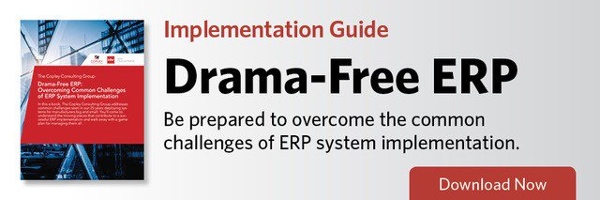In this special blog series, we’ll be discussing common challenges we’ve seen in our 25 years deploying ERP systems for manufacturers big and small.
According to a recent Forbes article, the popularity of cloud computing is exceeding the predictions of many industry analysts and advisory firms, boosting optimism about the future of the technology. International Data Corporate (IDC) now predicts that cloud-based technology will make up at least half of IT spending by 2018 and will account for 60% to 70% of all Software, Services, and Technology Spending by 2020.
But it’s not just advisory firms who recognize the upward mobility of the cloud. Nearly three-quarters of Tech Chief Financial Officers (CFOs) expect cloud computing to have the most measurable impact on their business in 2017. Adoption has even seen an increase among mid-tier and small and medium businesses. And yet, when it comes to trading an on-premise system for a cloud-based ERP, reservations remain among some small and mid-size manufacturers.
In this blog, we’ll look at some common areas of concern and how modern cloud-based ERP systems are upending persistent misconceptions.
Security
Fear of the unknown may be at the heart of suspicions regarding cloud security. Many manufacturers have long relied upon and trusted their own IT infrastructures, but in many cases the cloud is equal to, if not greater than, the security of an on-premise system. Cloud-based ERP systems make it easy to guard against viruses, malware and breaches with tighter security protocols and continuous threat assessments, including in-stream packet scanning and multi-layer firewall testing. Not only that, but rather than installing security software one server/location at a time, this heightened layer of security is reliably rolled out to all customers all at once – and without interruption.
Reliability
No system is foolproof. So, when outages from Amazon and Microsoft make headlines, it’s not surprising that it stirs up concern over the reliability of cloud technology. But just because cloud interruptions can happen doesn’t mean they are the norm – or that storing your ERP server in an on-site IT closet guarantees less downtime. But what if those servers aren’t appropriately backed up or fail? That’s the dangerous type of downtime that can be difficult to bounce back from.
Minimized downtime is the value proposition and lifeblood of ERP system vendors, so their businesses are built upon continuously validated, geographically dispersed and fully replicated disaster recovery capabilities. On top of this, version-less software upgrades happen in the background of cloud-based systems, eliminating the outages and operational disruptions that can accompany on-premise system updates.
Cost
Maintenance of an on-premise system comes at a cost – and it’s not just totals at the bottom of software and hardware bills. Even the savviest of IT departments will need to maintain their on-premise system with additional servers, sometimes-costly licenses and an intricate web of networking technologies. On top of these hard costs, there’s the man-hours that goes into purchasing, troubleshooting and managing in-house technologies.
Cloud-based ERP system vendors offer a software-as-a-service (SaaS) model, where companies pay a monthly subscription fee that can be expensed as an operating cost, freeing up capital and resources for other mission-critical needs. This not only minimizes upfront investment but eliminates ongoing IT costs associated with maintaining equipment, software and dedicated staff for an on-premise solution.
The result? A cloud-based ERP system that will more than pay for itself through more predictable cash flow management, heightened security measures and strengthened reliability, time and time again.

